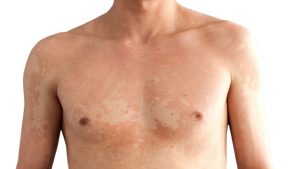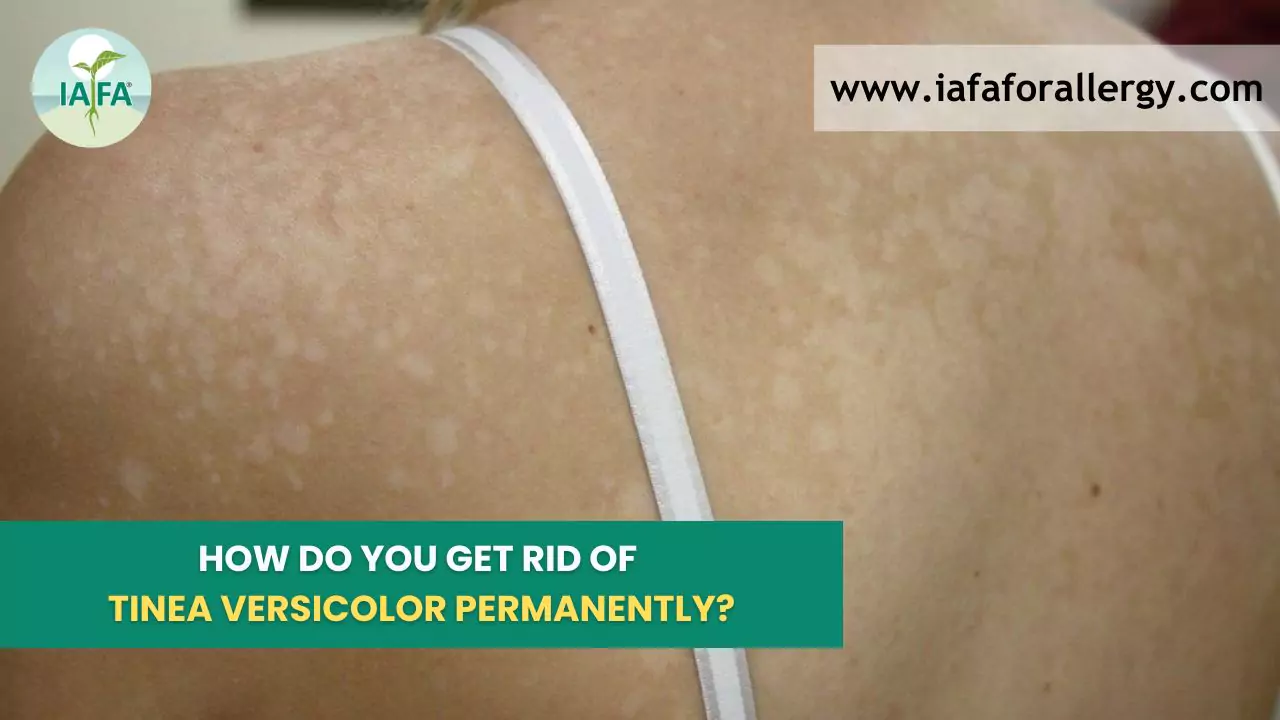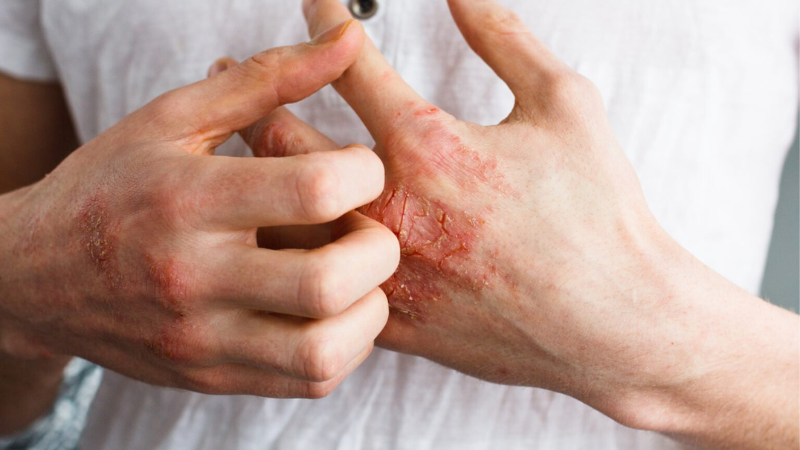Tinea Versicolor is a common skin disease that causes discolored, scaly patches on your skin. You can find these patches itchy, dry, and it keep recurring if proper treatment is not followed.
Tinea versicolor shows up as frustrating discolored, scaly spots on your chest, back, or arms. It’s not dangerous or contagious, but it can really affect how you feel.
That’s where Ayurveda comes in. At IAFA®, Dr. Sahil Gupta (B.A.M.S., M.H.A.) use ayurvedic science to calm the skin and prevent those patches from returning permanently.
In this article, you’ll understand how to get rid of Tinea Versicolor permanently. You’ll also learn some easy home remedies for Tinea Versicolor later on.
What is Tinea Versicolor
Tinea Versicolor is a fungal infection caused by Malassezia, a fungus that is usually found on our skin and dead tissues. It might not be harmful, but the disease can be highly demoralizing.
Ayurveda defines it as Riksha Jihva, and in the Charak Samhita, master Charak had categorized it into Kusta Roga.
Let’s discuss the major symptoms of Tinea Versicolor.
Tinea Versicolor Symptoms

Tinea Versicolor symptoms are patchy and scaly skin. You get patches all over the chest, under the neck, and on the upper arms.
Patches are visible, and you can easily recognize them. But, don’t confuse it with Eczema or Psoriasis!
Because Eczema(or psoriasis) is an inflammatory skin condition that causes red, dry, and highly itchy patches, but the Tinea Versicolor is discolored, scaly, and less itchy.
Major Tinea Versicolor symptoms are –
- Skin discoloration patches on your skin, especially on the chest, back, arms, and neck. The patches may be lighter or darker in shade.
- Scaly skin is common.
- Dry patches with slight itch.
Most of our patients regain clear skin and confidence through consistent Ayurveda care and targeted lifestyle shifts.
Causes of Tinea Versicolor
| Cause | Description |
|---|---|
| Fungal Overgrowth | Overgrowth of Malassezia fungus disrupts normal pigmentation and causes patches. |
| Weakened Immune System | Low immunity allows the fungus to grow more easily. |
| Oily Skin | Oily skin provides an ideal environment for Malassezia to overgrow. |
| Hot and Humid Climates | A study shows that Humid environments promote fungus growth, and you have a 40% higher risk of infection if you live in a humid climate. |
| Hormonal Changes | Hormonal fluctuations during adolescence and especially during pregnancy may trigger the infection (which is a temporary condition). |
| Excessive Sweating | Perspiration creates a moist environment that favors fungus growth. |
| Heredity of Disease | Research shows that first-degree relatives are 22.2% genetically more susceptible to developing tinea versicolor if there’s a family history of this infection. |
Best Treatment for Tinea Versicolor to Get Rid of It Permanently
Ayurveda offers you the best treatment to eliminate Tinea Versicolor permanently.
You might be unaware, but Ancient Ayurveda is 5000 years old, and it uses natural herbs to treat diseases holistically. Sometimes, all you need to do is trust the process.
Ayurveda offers a holistic and comprehensive therapy plan, along with a supportive guide, to help you maintain your health along with preventing future infections and diseases.
- Treatment with Natural Herbs
- IAFA’s Special Anti-Fungal Kit
- Tinea Versicolor Foods to Avoid
- Tinea Versicolor Diet
Let’s discuss these points to give you clarity on how to treat Tinea Versicolor disease with herbs.
1) Natural Remedies (Herbs) for Tinea Versicolor
10 powerful herbs that can help you treat the infection naturally. You can also treat Tinea Versicolor at home with home remedies that you’ll learn below.
Major herbs to naturally treat Tinea Versicolor are –
- Rakta Chandana – has cooling properties on the skin
- Lodhra – an anti-inflammatory herb
- Neem – Antiseptic and antifungal
- Aragwadha – a natural anti-allergic and purgative herb ideal for allergy treatment
- Aloe Vera – anti-inflammatory and ideal for skin hydration
- Coconut Oil – antifungal and a natural moisturizer
- Eucalyptus Oil – Cooling effect and antifungal
- Changeri – a natural antifungal herb that is rich in vitamin C, having wound-healing properties
- Haridra (Turmeric) – antibacterial, anti-inflammatory, antifungal, antimicrobial, and wound-healing properties
- Chakramarda – antifungal, anti-inflammatory, and anti-psoriatic properties
Let’s discuss two easy home remedies for Tinea Versicolor –
- Neem – Neem is one of the best home remedies for Tinea Versicolor. Neem has antifungal and antibacterial properties that help soothe irritation and keep infections under control.
How to use – You can boil Neem leaves in water until the quantity reduces by half. Wash the infected area with neem water. - Coconut oil for tinea versicolor – Coconut oil is another home remedy for Tinea Versicolor. Coconut Oil not only moisturizes the affected area, but it also possesses antifungal properties that help in preventing fungal growth.
How to use – After thoroughly cleaning the infected area, you can apply coconut oil directly to the skin. Use virgin coconut oil or pure coconut oil without any added fragrances, chemicals, or preservatives.
Apart from home remedies, you can also get an expert’s advice right away from our Ayurvedic expert, Dr. Sahil Gupta, and avail the best treatment for Tinea Versicolor if you want a one-to-one therapy.
Dr. Sahil is a highly experienced Ayurvedic expert having 14+ years of experience in Ayurveda medicine. He has already treated around 50,000+ patients all around the world by using ancient Ayurvedic herbs. He guides his patients to adopt an Ayurvedic lifestyle for healthy living.
2. IAFA’s Special Anti-Fungal Kit
IAFA’s Special Anti-Fungal Kit is crafted by the experts at IAFA Ayurveda®. You’ll find time-tested herbs like Aragwadh, Lodhra, Daru Haridra, Khadira, Sariva, Kamal Kesar, and natural oils like Coconut oil to care for your skin naturally.
External Treatment for Tinea Versicolor –
I) IAFA AF-7 Cream
AF-7 cream has great anti-microbial and skin protective properties. The cream helps you treat fungal infections, itching, and burning sensations.
Apply AF-7 cream twice daily after the bath to moisturize the skin.
II) IAFA AF-7 Bar
AF-7 Bar is a herbal soap prepared with herbs like lodhra, madhuka, Nimba, rakta Chandana, and other potent ingredients that are useful for the treatment of fungal infections.
AF-7 Bar has shown immense results in tinea versicolor patients.
III) IAFA 333 Shampoo
You can use 333 Shampoo to treat fungus infections as well as control dandruff. The 333 shampoo helps you to keep all fungal infections at bay.
Internal Treatment for Tinea Versicolor –
Internal medications involve useful herbal remedies that detoxify your body and boost immunity.
I) Aahar Amrutham Ras
Ahar Amrutham Ras thoroughly focuses on strengthening the Jathar-agni, the digestive fire, to digest food properly, so that toxins don’t accumulate in the body. This boosts immunity because, as the saying goes, “A clean body is a strong body.”
Since a weak immune system accumulates toxins in the body, which can worsen Tinea Versicolor.
II) Kutaj Ghanvati
Kutaj Ghanvati maintains gut health issues like diarrhea, stomach pain, indigestion, and ulcers. Kutajghan vati is made of two potent herbs, Kutaj and Ghan, which calm aggravated Kapha and Pitta. The herbal medicine improves digestive fire and bowel movement.
III) IAFA Detox Powder
IAFA Detox Powder helps in the whole body’s detoxification. The detox powder removes Ama visha (toxins) from the body and keeps your body healthy and highly immune. Improving immunity will surely help you fight this disease effectively.
IV) IAFA AF-7 Tablet
IAFA AF-7 Tablet is packed with the goodness of all essential herbs like Nimba, Triphala, which fight fungal infections and give massive results in patients of Tinea Versicolor.
By following these medications, you can get rid of Tinea Versicolor.
3) Tinea Versicolor Foods to Avoid
In Ayurveda, a balanced diet plays a huge role in healing. Ayurveda has two concepts –
- Apathya – Food harmful to the body
- Pathya – Food acceptable to the body
When you take care of Pathya and Apathya, it enhances the effect of the herbal treatment. But Dr. Sahil Gupta thoroughly recommends a personalized diet to every patient, depending on their dosha imbalance, food allergies, and intolerances.
Let me give you a glimpse of Apathya that you should follow. But please consult our Ayurveda Expert before you start any diet or treatment.
Apathya (Tinea Versicolor Foods to Avoid)
- Always avoid excessively sweet, salty, spicy, and sour food.
- Don’t consume fermented beverages and bakery stuff.
- Avoid packaged and processed food
- Try to avoid heavy foods that are hard to digest.
- Say no to milk and dairy.
You should also avoid things mentioned below to prevent Tinea versicolor –
- Sleeping more during the daytime.
- Not doing enough exercise.
- Not maintaining good sleep hygiene and routine.
- Worrying and stressing out over simple things.
- Lack of personal hygiene.
- Wearing tight and unclean garments.
4) Pathya (Tinea Versicolor Diet)
You can find Pathya foods that are recommended in Tinea Versicolor are –
- Make a habit of drinking lukewarm water.
- Always consume easily digestible food like rice, dal, or cereals.
- Eat food that is fresh and warm
- Eat the food within 4 hours of preparing it
- Drink adequate water.
- Include foods like Green gram, Pomegranate, and Gooseberry in your daily diet.
- Maintain at least a 4-hour gap between your meals.
You should also follow the lifestyle mentioned below to cure Tinea Versicolor.
- Start doing mild to moderate exercises.
- Maintain personal, social, and environmental hygiene.
- Wear loose and dry garments.
- Wash your clothes, bed covers, pillow covers, and other garments very often.
- Exposure to mild sunlight daily in the morning and evening, but avoid strong sunlight as it may worsen the condition.
- Sleep a minimum of 7 hours daily
- Maintain a positive, stress-free mind.
Okay, I hope you got your answer to “How do I get rid of Tinea Versicolor?” If you still have any queries or doubts, you can connect with our Ayurveda expert via video call and get answers to all your queries and other dilemmas.
How Can You Know You Get Tinea Versicolor
If you find scaly, discolored patches on the skin, mostly on the chest, neck, back, and arms, high chances are you are getting Tinea Versicolor.
Tinea Versicolor Patches can be dry and sometimes itchy as well.
If you sweat excessively, take extra care because Tinea Versicolor may worsen in hot, humid weather or after excessive sweating.
What Can Worsen This Condition
You should be aware of the following conditions to get rid of Tinea Versicolor-
- Hot and Humid climates
- Damp and warm weather
- Weakened immunity
- Hormonal changes during adolescence and pregnancy
- Oily skin favors the growth of fungus on your skin and may exaggerate the condition.
When to Consult an Ayurvedic Doctor
You should seek professional help if:
- Spots return every summer despite home remedies.
- Discoloration spreads or doesn’t improve within 8–12 weeks.
- Conventional creams only give temporary results.
At IAFA®, Dr. Sahil Gupta creates personalized herbal, detox, and lifestyle plans to stop the cycle for good.

Frequently Asked Questions
Q1. Is Tinea Versicolor permanent?
Ans. No. Tinea Versicolor is not a permanent disease, but it can be recurring if your immunity is compromised.
You can follow Ayurvedic herbal treatment for permanent cure.
Q2. Can Tinea Versicolor be cured?
Yes. Tinea Versicolor can be cured permanently with herbal treatment.
Q3. Why do Tinea Versicolor infections tend to recur even after treatment?
Ans. Recurrence of Tinea Versicolor is common because conventional treatments suppress the symptoms rather than curing the root cause.
Secondly, when conditions like a weak immune system or a humid environment arise, the fungus can overgrow again.
Q4. Are natural remedies like Tea Tree oil as effective as pharmaceutical options?
Ans. Yes. Natural remedies are not only effective but also safer than conventional drugs.
Q5. What lifestyle changes can help prevent the recurrence of Tinea Versicolor?
Ans. Following Ayurvedic lifestyle can help you prevent the recurrence of disease.
Ayurveda allows you to consume Pathya foods like green gram, pomegranate, and gooseberry, and avoid Apathya foods such as overly sweet, spicy, or processed items.
Along with that, you should drink lukewarm water, eat fresh meals, exercise moderately, and maintain hygiene to avoid recurrence of Tinea Versicolor.
Q6. Why does Tinea Versicolor have such a high rate of recurrence despite treatment?
Ans. Because conventional treatments only suppress the symptoms rather than addressing the root cause.
Q7. How long should I wait before expecting skin color to normalize after treatment?
Ans. It varies person to person, usually skin color normalizes within 12 weeks.
Q8. What hygiene routines can minimize the risk of recurrent infections?
Ans. Bathing with mild soap regularly and keeping the skin dry minimizes the risk.
Q9. How long does skin pigmentation usually stay altered after treatment?
Ans. approx. 8 to 12 weeks.
Q10. What factors influence the persistence of skin color changes?
Ans. Your skin type, exposure to sun and regeneration rate of the skin.
Q11. Could untreated Tinea Versicolor lead to permanent skin damage?
Ans. Not permanent skin damage but your infection would take long time for healing starting from several weeks to months.
Our Final Verdict
To permanently eliminate Tinea Versicolor, follow the lifestyle mentioned above.
For expert guidance and proven natural treatment, you can book an online consultation with Ayurvedic expert Dr. Sahil Gupta to avail the best treatment for Tinea Versicolor,
Dr. Sahil has 14+ years of experience and has treated over 50,000 patients globally using ancient Ayurvedic herbs and lifestyle recommendations.
Every day, IAFA® adds new success stories of healing and transformation.
We want you to be the next. You deserve a healthy and happier life, and we’re here to help you achieve it because “Your Health is Our Priority.”







